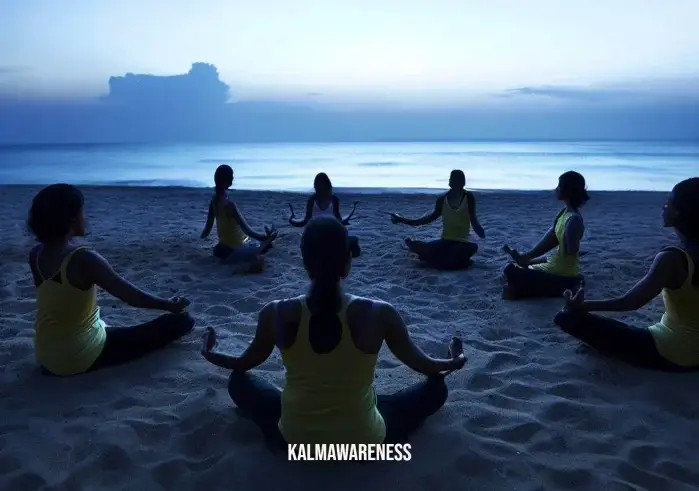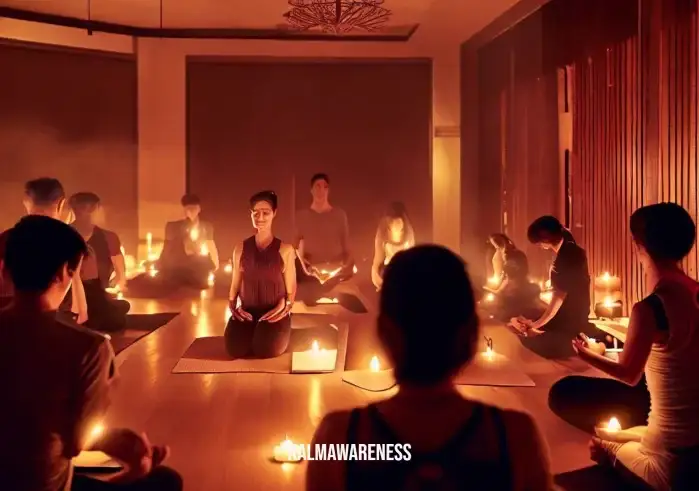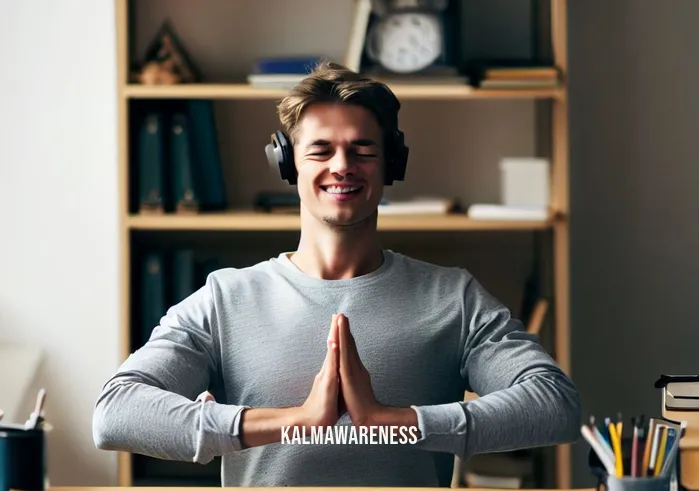Reclaiming Peace: 22 Minutes Angry Yoga for Emotional Release
When it comes to managing emotions, particularly those of anger and frustration, a unique yet effective solution is 22 minutes angry yoga. This is more than just a simple sequence of asanas; it’s an empowering blend of movement, expression, connection, and release that holistically address your emotional state.
The Power of Angry Yoga
The transformative practice of 22 minutes angry yoga is specifically designed to help you navigate through anger and emerge feeling lighter, stronger, and more at peace. We are often taught to suppress anger, but according to Brené Brown’s definition of love, self-love involves acknowledging all of our emotions and learning how to manage them constructively.
“In dealing with our anger, it’s crucial that we address it head-on and with empathy for ourselves.”
22 minutes angry yoga encourages us to channel our anger into our practice, to move through the poses with mindful awareness of our emotional state, and to let the energy of the anger empower our movements.
In this emotional exercise, anger isn’t seen as a negative or harmful emotion. Instead, it’s viewed as a potent force for transformation and growth. As we physically express and release our anger through yoga, we also create a safe space to explore and understand our feelings.
Emotional Release Through Movement
Emotion and movement are deeply interconnected. When we move our bodies intentionally, we can directly influence our emotional state. This is why yoga, in general, is such a powerful tool for emotional wellbeing, and why 22 minutes angry yoga can be especially beneficial for managing and releasing pent-up anger.
Consider the words of Brené Brown in her two-word check-in, where she encourages us to acknowledge and express our current emotional state. We could use the same approach to our 22 minutes angry yoga practice. By naming our anger and giving it a physical expression, we create an outlet for this powerful emotion to flow through.
As we transition through various poses in this chakra-soul stimulating practice, our anger begins to dissipate. We learn that we are not our anger, and we don’t have to be controlled by it. This realization can be as refreshing as crying after meditation – a catharsis that comes from letting go.
This is the first part of our exploration into 22 minutes angry yoga and its transformative power. As you continue reading in the next chapter, you’ll learn more about how this practice aligns with mindfulness, how it aids in fostering an emotional connection, and how you can integrate it into your daily routine. Don’t forget to let your mind open and prepare for an enlightening journey of emotional self-discovery.

The Structure of 22 Minutes Angry Yoga
The 22 minutes angry yoga is not a random assortment of poses. Rather, it’s a thoughtful sequence designed to foster release and transformation. As we delve deeper into this practice, it’s vital to grasp its structure and the underlying intention behind each stage.
1. Grounding (5 minutes)
The practice starts by creating a grounded and mindful space to invite our anger in, rather than trying to stop negative thoughts. This is not about trying to clear your head of anger but about recognizing and accepting it.
2. Activation (5 minutes)
The second phase aims to get your energy moving. Think about how it feels when you’re not feeling yourself, and let that awareness drive your movements.
3. Peak (7 minutes)
The peak stage is where your anger fully expresses itself. This is the point where we need to remind ourselves that we are not our pain, a lesson beautifully articulated here.
4. Wind Down (3 minutes)
As the session winds down, it’s about letting go, similar to the sense of forgiving, forgetting, and moving on. It’s the stage where we start to find peace with our anger.
5. Meditation and Reflection (2 minutes)
The final two minutes of our 22 minutes angry yoga are devoted to stillness and reflection, wherein the lessons from emotional healing meditation can be useful.
The Impact of 22 Minutes Angry Yoga on Emotional Management
To better understand the impact of 22 minutes angry yoga on emotional management, let’s examine how it affects our brain, body, and feelings:
| Area | Impact of Angry Yoga |
|---|---|
| Brain | The practice helps us gain better control over our reactions, promoting more self-reflection and emotional maturity (are you emotionally mature?). |
| Body | Angry yoga can lessen the physical strain caused by emotional stress, like the feeling of emotional weight on shoulders. |
| Feelings | Angry yoga promotes emotional release, enabling us to let go of pent-up anger, similar to the sensation of releasing something inside you that’s hard to explain. |
In this chapter, we have delved deeper into the structure of 22 minutes angry yoga and its impact on emotional management. In the next part of this article, we will explore the wider benefits of this practice, connecting it to concepts of mindful movement and holistic wellness. By integrating this practice into your routine, you could be stepping into a more empowered and authentic version of yourself. Let’s continue this journey of self-exploration and self-expression through yoga.

Deepening the Practice of 22 Minutes Angry Yoga
The practice of 22 minutes angry yoga is an exploration of our internal landscapes, providing us with tools to navigate the tumultuous waters of our emotional self. We continue this journey, delving into the heart of this transformative practice.
Mindfulness and Connection in Angry Yoga
Angry yoga is not just about venting frustration; it’s about forming a deeper connection with oneself and a mindful understanding of our emotions. As renowned researcher and author Brené Brown states, “Vulnerability is not winning or losing; it’s having the courage to show up and be seen when we have no control over the outcome.”
This practice asks us to be vulnerable, to show up and engage with grace in the face of our anger. It’s about exploring the complexity of our feelings, including curiosity, an important emotion we might experience on this journey.
Integrating the Body and Mind
22 minutes angry yoga is a dynamic, embodied practice that integrates the body and mind. As we’ve seen in our understanding of the 8th chakra, this body-mind connection is critical in facilitating emotional release and growth.
In this practice, we harness the power of mindful movement to traverse the chasms of our emotional self. As we move and breathe, we mirror the interconnected community of our body and mind, forming a more cohesive understanding of our emotional terrain.
Embracing Anger and Emotional Freedom
Renowned psychologist Carl Jung once said, “Everything that irritates us about others can lead us to an understanding of ourselves.” The practice of 22 minutes angry yoga is a testament to this. It helps us move past disarming the narcissist within us and build towards emotional maturity.
Through this transformative practice, we learn to channel our anger in a healthy, constructive way, instead of letting it weigh us down like an emotional weight on our shoulders. This emotional freedom creates space for personal growth, leading us to a state of conscious forgiveness and deeper self-understanding.
In this chapter, we have broadened our understanding of 22 minutes angry yoga, illuminating the profound potential this practice holds for personal transformation. In the next part, we will explore how to integrate this practice into our daily lives, making anger our ally rather than our adversary. Let’s continue to harness the power of anger, transforming it into a catalyst for growth and change.

Incorporating 22 Minutes Angry Yoga Into Your Daily Life
22 Minutes Angry Yoga isn’t just a practice for the yoga mat; it can be an integral part of your everyday life, providing you with the tools to navigate anger and emotional turbulence. As you continue reading, discover how to seamlessly integrate this transformative practice into your daily routine.
Applying Angry Yoga Techniques Daily
Incorporating 22 Minutes Angry Yoga into your daily life begins with a conscious decision to acknowledge and explore your anger rather than avoid or suppress it. As stated by Brené Brown in her piece on love definitions, “We cultivate love when we allow our most vulnerable and powerful selves to be deeply seen and known, and when we honor the spiritual connection that grows from that offering with trust, respect, kindness, and affection.”
Morning Routine
Your morning routine is an excellent opportunity to set the tone for the day ahead. Consider setting aside time for a short 22 Minutes Angry Yoga session each morning. During this session, consciously acknowledge your feelings, remembering that it’s okay to not feel yourself at times. This daily practice can help clear your head and provide a more focused start to your day.
Managing Stressful Situations
Angry Yoga techniques can also be applied during stressful situations. The next time you find yourself in the midst of emotional turbulence, pause and practice a few minutes of Angry Yoga. Breathing deeply and consciously moving can help alleviate the pressure of the situation.
| Time of Day | Angry Yoga Practice | Benefit |
|---|---|---|
| Morning | Short session to start the day | Clear mind, focused start |
| During Stressful Situations | Few minutes of conscious movement and deep breathing | Alleviate pressure, manage emotions better |
| Evening | Longer session to wind down | Process emotions, relax |
Hope and Confidence Through Angry Yoga
The practice of 22 Minutes Angry Yoga offers a sense of hope and confidence in our ability to manage and express our emotions. As Eckhart Tolle says, “You are not your pain.” Engaging with this practice allows us to fully experience, understand, and release our anger, transforming it into a source of personal growth.
By routinely practicing 22 Minutes Angry Yoga, we build our capacity to manage our emotions, leading to greater self-understanding and inner resources for personal growth. It’s about learning to let go of everything you fear to lose and embracing the transformative power of anger.
In this part of our exploration of 22 Minutes Angry Yoga, we’ve discovered practical ways to incorporate this practice into daily life and understood the sense of hope and confidence it can provide. Continue on to the next part of our series as we delve deeper into the science behind the practice, gaining insight into why and how it works so effectively.

The Science Behind 22 Minutes Angry Yoga
In the world of emotion management and self-awareness, the 22 Minutes Angry Yoga technique has gained remarkable traction. But what is the science that underpins this unique form of emotional release and self-expression? This section will unveil the neuroscience and psychological principles that make 22 Minutes Angry Yoga such an effective tool in emotional regulation and introspection.
The Neuroscience of Anger and Yoga
Anger, like any other emotion, is fundamentally a biochemical reaction in the brain. When you’re angry, your brain triggers a response that releases various hormones, including adrenaline and cortisol. This physiological response is what gives rise to the sensations we associate with anger, like a racing heart or flushed skin.
Neuroscientist Andrew Huberman of Stanford University, in his groundbreaking research, explains that specific breathing patterns and bodily movements – both integral components of yoga – can help control our autonomic nervous system. This control directly influences our emotional state, and in the context of Angry Yoga, it enables us to better manage and express our anger.
The Psychology of 22 Minutes
There’s a particular significance to the “22 minutes” in 22 Minutes Angry Yoga. Psychologically speaking, it takes approximately 21 days to form a habit. By practicing this technique daily for the same duration – 22 minutes – it’s designed to help cultivate a sustainable habit of emotional regulation and expression.
“You are not your pain, but what you do with your pain defines you.” – Brené Brown
Brené Brown’s perspective on emotional maturity aligns perfectly with the principles of 22 Minutes Angry Yoga. It is not about suppressing your anger; it’s about using it as a catalyst for personal growth.
The Integration of Mind and Body
Lastly, 22 Minutes Angry Yoga underscores the importance of the mind-body connection. Yoga, at its core, is a physical practice that promotes mental well-being. When practicing Angry Yoga, the asanas (poses) and pranayama (breathing exercises) serve to bridge the gap between mind and body, fostering an integrative approach to emotional regulation.
For example, a pose like the “Warrior” might serve as an embodiment of confronting one’s anger, while the controlled breathing exercises may mirror the process of managing and releasing emotional tension.
This integrative approach to emotional management is also apparent in other resources on the website, such as the name it to tame it worksheet and articles on calming the limbic system.
We’ve now explored the science behind 22 Minutes Angry Yoga and the profound effects it can have on our emotional landscape. In the next chapter, we’ll examine some real-world applications of this practice and hear from those who’ve experienced its transformative effects firsthand.

Applying the 22 Minutes Angry Yoga in Daily Life
Now that we have delved into the depths of the science and psychology behind 22 Minutes Angry Yoga, it’s time to see how this empowering technique can be applied in our day-to-day lives. In this final chapter, we will explore some practical advice on integrating this form of yoga into our routines, and we will hear from individuals who have personally experienced its transformative benefits.
Starting Your Angry Yoga Journey
One of the crucial aspects of 22 Minutes Angry Yoga is the creation of a personal space conducive to the practice. This area should be quiet and free of disruptions, a place where you can focus solely on your emotions and movements. The significance of creating such a space aligns with the broader concept of mindful places where the external environment aids in promoting internal tranquility.
The next step is to decide on a regular time for your practice. Since this form of yoga requires focus and dedication, it’s beneficial to practice at a time when your energy levels are at their peak. As the personal growth journal prompts suggest, self-reflection and mindfulness practices yield the best results when your mind is alert and receptive.
Transformational Experiences
Many practitioners of 22 Minutes Angry Yoga have shared the profound impact this practice has had on their lives. One individual who felt particularly untensed after the practice described it as an emotional purge, followed by an unexpected tranquility.
Another practitioner, struggling with persistent negative thoughts, found that this form of yoga offered a unique way to confront and stop negative thoughts. Over time, they noticed a significant reduction in the frequency of these thoughts and a notable increase in their overall emotional well-being.
Parting Thoughts on Angry Yoga
As we conclude this exploration of 22 Minutes Angry Yoga, we hope that you’ve gained a deeper understanding of this unique form of yoga and the ways it can foster emotional management and release.
“To let go is to release the images and emotions, the grudges and fears, the clingings and disappointments of the past that bind our spirit.” – Jack Kornfield
This quote beautifully encapsulates the essence of 22 Minutes Angry Yoga: a journey of releasing pent-up emotions, embracing self-expression, and ultimately, cultivating a healthier relationship with ourselves.
Thank you for taking this journey with us, and we invite you to continue exploring other topics on emotion management, mindfulness, and personal growth on our website. Whether it’s learning to engage with grace, understanding interconnected community, or exploring the power of forgiveness, we have a plethora of resources waiting for you.




